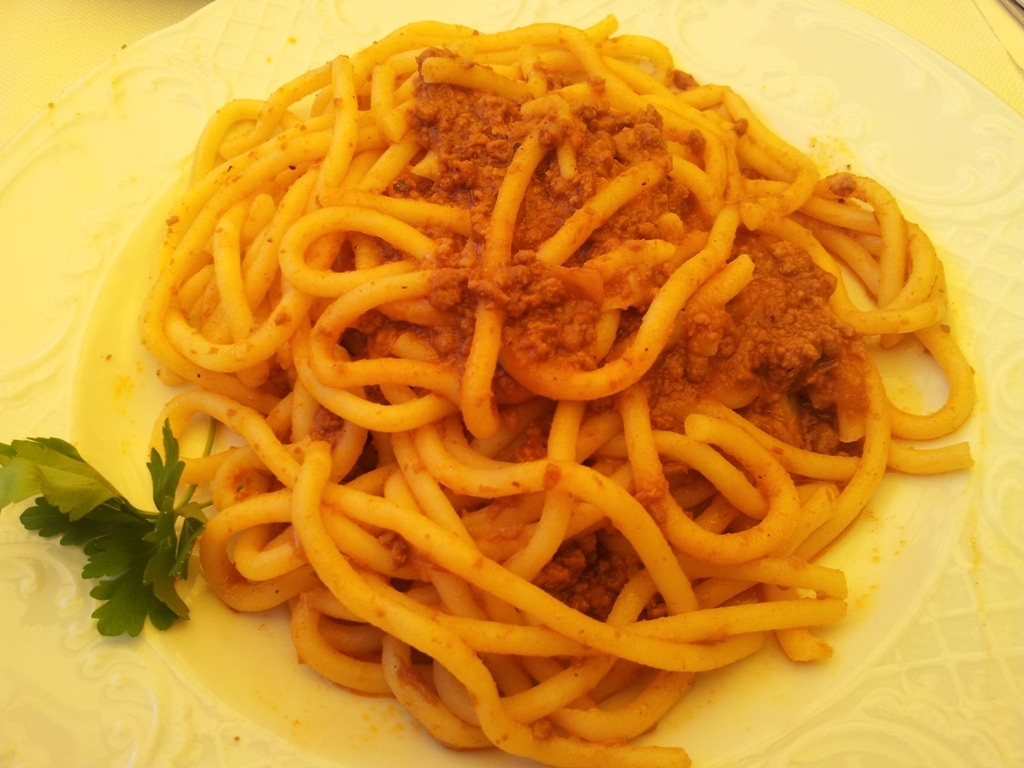With a strikingly beautiful landscape, seemingly countless picturesque hill towns, an amazing art-filled history, and a resulting popularity with English-speaking tourists, “Tuscan” was ripe for exploitation by marketers. What is actual Tuscan food?
There is no one answer and the cuisine changes throughout the region, especially going from the coast inland, as with most of Italy. It is basically hardy and more meat-driven than other regional Italian cuisines and maybe a little less exciting. Among other things, the typical bread is salt-free, and blander, the cheeses less grand or interesting, there are more soups than pastas, the olive oil is excellent and ubiquitous, and the region is the home of Italy’s most traditional, and best, steak dish, the fiorentina. And, the red wine, necessarily for nearly every meal, is not too bad, either.
I’ve been fortunate to travel to the region several times over the past dozen or so years. The associated list contains ten dishes I had on somewhat recent trip in late November to the area in southern Tuscany around Montalcino. It is not meant to be comprehensive, and it reflects the late autumn season, so fewer greens, but it includes dishes I have had on past trips.
Antipasti – crostini and bruschette
The bruschetta topped with diced tomatoes might be the most familiar dish to make the transition from Tuscany to America’s restaurant tables. Even in November, the tomatoes served were ripe, juicy and very flavorful. Aided by excellent olive oil that had been pressed a couple of weeks earlier and a hint of garlic, these were tough to quit for me.
The similar crostini were nearly as good. Here one is topped with a puree of black olives, not unlike a tapenade. The other featured a squash puree. Both were delicious. Mushrooms and a red pepper puree as crostini toppings also made appearances at other meals during the trip, but not the classic crostini di milza, featuring minced spleen.
Antipasti – grissini, prosciutto, crostino, bread, cheese
More specifically, this mixed antipasti plate, grissini con prosciutto toscano, crostino con olio extra vergine novello, Grana Padana, focaccia, and pecorino Toscano. Grissini is not Tuscan, it’s originally from Turin, but it is sufficiently Italian that you will find it over much of Italy, especially in restaurants. It makes for a neat way to serve a piece of prosciutto.
A simple piece of toasted bread is a perfect way to showcase the freshly pressed, fruity and delicious new olive oil. This type of focaccia might be an import from neighboring Liguria, but it is also popular in parts of Tuscany and a nice addition to this plate, as was the Grana Padana, a great eating cheese similar to Parmigiano that is eaten throughout the country.
Antipasti – Pecorino, sausage, prosciutto, capocollo
Pecorino di Pienza is regarded to be the best cheese produced in Tuscany. At least several of our hosts – including a French winemaker who was more fond of his homeland’s cheese – were asserting that, and I had to agree. It was delicious at the three-month and six-month stages.
The Tuscan prosciutto is less flavorful and delicate than the great prosciutti – Parma, San Daniele, and Carpegna – but it is still usually excellent, and much better than we get from North America. I ate more than my share, as I typically do. The Capocollo is air-cured meat from a pork shoulder served thinly sliced. It is different than the more familiar southern Italian varieties more commonly found here. The Tuscan version might be more delicate, but still with an enjoyable garlic bite.
Primo Piatto – lasagne
This might be an adaption of the famous dish that originated in Bologna, but the Tuscans, like much of Italy, seem to have long-loved this stuffed pasta creation. You certainly find it on restaurant menus, especially near tourist centers.
The dish we had – well, dishes, as we were served similar lasagnas at lunch and a dinner at two different places – featured ragù bolognese, béchamel, a hint of tomato, and obviously freshly made pasta. Both were terrific, and surprisingly light.
Primo Piatto – pinci
The only indigenous Tuscan pasta is pici, which is called pinci in the area around Montalcino where I was. It is basically a fat freshly made spaghetti noodle. These soft strands of pasta worked very well with the ragù bolognese, which is one of the creations that has country-wide currency.
Primo Piatto – ribollita
The famous hearty bean soup was a welcome dish on a cold, wet night. As tasty as it was, I am sure it was even better the next night. We were instructed to add thinly sliced red onions on top, a Tuscan tradition. Of course, a drizzle of two of the two-week old olive oil was also very complementary.
Primo Piatto – crema di ceci
If not nearly as hearty as the ribollita, a hot bowl of soup featuring a puree of chickpeas, was equally as welcome on a cool day. A hint of rosemary, just made croutons, and more of the fresh olive oil made this fairly simple dish irresistible.
Secondo Piatto – rosbif
Slices of roast beef might not be expected in Tuscany, but the region seems to serve much more beef than elsewhere in Italy – at least enjoyable beef dishes – not just the famous bistecca alla fiorentina, but also tagliata, slices of steak served under arugla is commonly found. The Chianina Valley in Tuscany is home to Italy’s most famous breed of cattle.
Whether or not most of the beef currently found in the region comes from these cows, it left the region with a beef-eating tradition that was certainly bolstered by the long tradition of tourists from Britain. By the end of the last century the popularity of Tuscany, especially the gorgeous Chianti Classico wine region, among the Brits gave rise to the nickname “Chiantishire.” Rosbif is the Italian way of saying “roast beef.” This time, the roast beef featured a tuna sauce, like in the vitello tonnato. It was the best of the beef dishes on the trip.
Secondo Piatto – spezzatino di cinghiale
Wild boar are a real problem for the grape-growers in the Montalcino appellation. These often very large animals have a taste for the sangiovese grape, the basis for their famous wines. Thankfully, these creatures often make it to the table and can be delicious, especially when stewed in a traditional manner such as this.
The result is rich, wonderful dish that might be just a touch gamy. It pairs perfectly with a ready-to-consume Brunello di Montalcino. It and steak might be the best matches for most Brunellos. I had second helpings of this stew and a few more of the Brunello.
Contorno – roasted potatoes
We had simple roasted potatoes on at least a couple of occasions as a side dish served with the secondi piatti. Lightly-herbed and perfectly cooked – most of the pieces had a nice crispness at its edges – these made for a proper addition to a meal on a blustery day. A drizzle of the first-rate olive oil made these even tastier.
A delicious plate of pici at a restaurant in Monteriggioni in southern Tuscany.

 RSS Feed
RSS Feed

